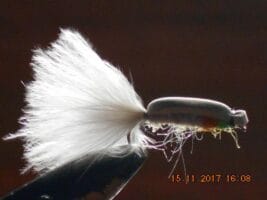Your cart is currently empty!
Floating fly white
Floating fly white Collection: Premium Surface Patterns The Floating fly white Collection represents a masterful approach to premium surface fly patterns design, combining realistic terrestrial imitations with proven fish-catching effectiveness. These meticulously crafted patterns feature carefully selected materials that create compelling surface profiles, making them particularly effective for targeting surface-feeding fish across various conditions. Design…
Description
Floating fly white Collection: Premium Surface Patterns
The Floating fly white Collection represents a masterful approach to premium surface fly patterns design, combining realistic terrestrial imitations with proven fish-catching effectiveness. These meticulously crafted patterns feature carefully selected materials that create compelling surface profiles, making them particularly effective for targeting surface-feeding fish across various conditions.
Design Excellence and Innovation
The collection showcases sophisticated design elements that set them apart from standard floating patterns. Each carefully proportioned fly provides perfect flotation and visibility, while the natural colorations create highly effective imitations of various terrestrial insects. The combination of buoyancy and natural presentation makes them particularly effective during prime surface-feeding periods.
Material Selection and Technical Construction
Every component is carefully selected for both performance and durability:
- Premium floating materials
- High-quality natural and synthetic dubbing
- Strategic hackle placement
- Durable thread base
- Specialized dry fly hooks
- Reinforced construction techniques
Strategic Fishing Applications
These patterns excel in multiple fishing scenarios:
- Calm water surfaces
- Riffled water
- Bank fishing
- Structure edges
- Various light conditions Each environment allows the patterns to showcase their effectiveness.
Seasonal Effectiveness?The collection demonstrates remarkable productivity throughout specific periods:
- Spring: Early insect activity
- Summer: Peak terrestrial season
- Fall: Late season opportunities
- Winter: Midday hatches Seasonal adaptations in presentation maximize success.
Species-Specific Performance?While primarily designed for trout, the patterns prove deadly for:
- Brown Trout sipping insects
- Rainbow Trout in riffles
- Brook Trout in small streams
- Bass near structure
- Various surface feeders
Water Presentation Characteristics?Superior presentation qualities include:
- Excellent flotation
- Natural silhouette
- Perfect profile
- High visibility
- Attractive movement
Advanced Retrieval Techniques?To maximize pattern effectiveness:
- Dead-drift presentation
- Subtle twitches
- Skated retrieves
- Stop-and-go action
- Surface wake creation
Technical Advantages?Key performance benefits include:
- Superior buoyancy
- Enhanced visibility
- Excellent hook-up ratio
- Durable construction
- Versatile fishing applications
Line and Leader Configuration?For optimal presentation:
- Weight-forward floating lines
- Long leaders (9-12 feet)
- Fine tippets (5X-6X)
- Degreased leader sections
- Proper turnover design
Environmental Adaptability?The patterns perform consistently across:
- Various light conditions
- Different water clarities
- Multiple current speeds
- Various temperatures
- Different weather patterns
Competition and Professional Applications?The Floating Fly Collection has established itself in serious angling:
- Tournament-proven patterns
- Guide’s choice for surface action
- Professional competition use
- Teaching patterns for dry fly fishing
- Reliable producers in challenging conditions
Size Variations and Pattern Modifications?Available in multiple configurations:
- Sizes 6-14 standard
- Various body densities
- Hackle style options
- Wing variations
- Color modifications
Storage and Maintenance Requirements?To maintain optimal performance:
- Store in ventilated compartments
- Avoid compression
- Regular hackle straightening
- Proper drying essential
- Flotant application methods
Advanced Rigging Techniques?Multiple rigging options enhance versatility:
- Traditional dry fly presentation
- Dropper setups
- Multiple fly rigs
- Specialized leader designs
- Indicator configurations
Historical Context and Evolution?The collection’s development reflects:
- Traditional dry fly patterns
- Modern material incorporation
- Refined proportions
- Proven effectiveness
- Continuous improvement
Quality Control Standards?Each fly maintains strict requirements:
- Precise material selection
- Proper proportioning
- Construction integrity
- Hackle placement
- Pattern uniformity
Fishing Location Selection?Optimal fishing locations include:
- Smooth glides
- Riffled water
- Current seams
- Structure edges
- Bank areas
Weather and Condition Considerations?Pattern effectiveness varies with:
- Wind conditions
- Cloud cover
- Temperature
- Barometric pressure
- Time of day
Presentation Techniques?Achieving proper presentation through:
- Accurate casting
- Proper mending
- Drift control
- Distance management
- Line control
Color and Profile Characteristics?The patterns provide:
- Natural coloration
- Perfect imitation
- High visibility
- Size-appropriate profiles
- Realistic representation
Movement Characteristics?Natural movement achieved through:
- Hackle action
- Body position
- Wing movement
- Current interaction
- Surface tension effects
Durability Features?Construction elements ensuring longevity:
- Reinforced hackle attachment
- Quality materials
- Proper proportioning
- Strategic material placement
- Hook point protection
Target Species Behavior?Understanding fish response to:
- Surface disturbance
- Pattern visibility
- Movement triggers
- Feeding patterns
- Strike triggers
Water Type Adaptations?Effective across various waters:
- Mountain streams
- Large rivers
- Spring creeks
- Lakes and ponds
- Alpine waters
Casting Techniques?Specialized casting methods:
- Accuracy casting
- Delicate presentation
- Line speed control
- Loop formation
- Wind adaptation
Strike Detection?Recognizing takes through:
- Visual observation
- Surface disturbance
- Leader movement
- Line reaction
- Sound detection
Hook Setting Techniques?Proper hook setting through:
- Timing considerations
- Pressure control
- Direction management
- Follow-through
- Fish behavior reading
Fighting Techniques?Landing fish effectively:
- Pressure application
- Direction control
- Line management
- Fish behavior adaptation
- Landing strategies
Additional information
| Hook type | Barbed Hooks, Barbless Hooks |
|---|---|
| Hook size | 10, 12, 14, 6, 8 |







